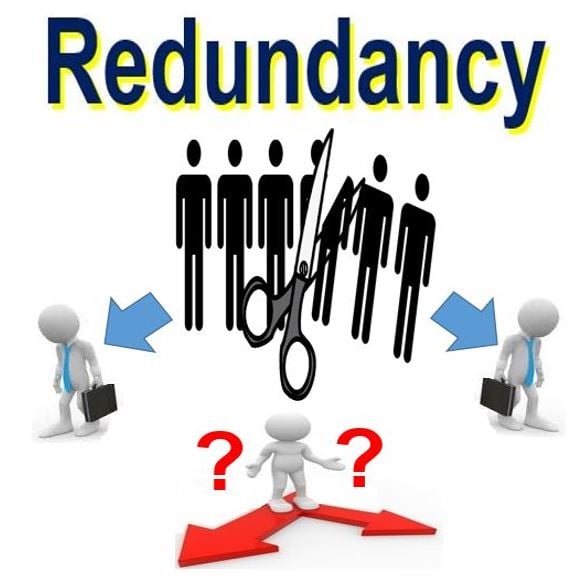Who Pays Redundancy Money? A Detailed Guide for Companies and Employees
Who Pays Redundancy Money? A Detailed Guide for Companies and Employees
Blog Article
Exploring the Interplay In Between Firm Redundancy and Organizational Versatility for Future Growth
In the dynamic landscape of today's service globe, the detailed partnership between company redundancy and business flexibility arises as a vital factor for continual growth and success. Business frequently face the difficulty of striking a delicate equilibrium between preserving a level of redundancy to reduce threats and promoting adaptability to respond promptly to the ever-evolving market demands.
Significance of Business Redundancy
Firm redundancy is a critical aspect that boosts business durability and alleviates functional dangers. By incorporating redundancy procedures within the business structure, firms can much better withstand unanticipated interruptions and variations in business atmosphere. Redundancy serves as a calculated barrier, permitting companies to adjust and respond properly to unanticipated challenges without compromising essential operations.
One key facet of the significance of company redundancy is its duty in ensuring connection throughout times of situation. When faced with unexpected changes or emergency situations, repetitive systems, resources, or workers can action in to keep crucial features and prevent prevalent disruptions. This continuity not only safeguards the business's online reputation and customer trust but likewise decreases monetary losses and operational downtime.

Strategies for Organizational Versatility

An additional crucial method is investing in technology and framework that can sustain adaptability and scalability. Implementing electronic devices, automation, and information analytics can enhance operations, improve performance, and supply important understandings for notified decision-making. Moreover, developing versatile business frameworks that enable for quick adjustments to market characteristics and client needs is vital for remaining competitive in a rapidly advancing setting. By proactively recognizing possible interruptions and chances, companies can proactively adjust and grow in an ever-changing business landscape.
Harmonizing Redundancy and Versatility
Achieving an unified balance in between operational redundancy and business flexibility is critical in browsing the intricacies of a vibrant business setting. Redundancy within a firm offers a safeguard, guaranteeing continuity and security in operations. Nevertheless, an unwanted of redundancy can bring about inadequacies and prevent flexibility to changing market conditions. On the various other hand, business adaptability enables companies to react promptly to outside interruptions and seize new possibilities. Striking the ideal equilibrium in between redundancy and adaptability is a delicate process that requires a deep understanding of the company's objectives, industry dynamics, and risk resistance.
To achieve this balance, business need to perform regular analyses of their procedures to determine locations where redundancy is needed for danger reduction and where flexibility can drive advancement and development. Implementing adaptable frameworks, fostering a society of continual learning and enhancement, and urging open communication across all levels of the company are crucial strategies to harmonize redundancy and adaptability successfully. By aligning these two crucial elements, companies can place themselves for lasting development and success in an ever-changing service landscape.
Study on Adjustment Success
In taking a look at instances of successful organizational adaptation, it ends up being obvious that the interaction in between functional redundancy and flexibility is a specifying element in shaping resistant services. A DVD rental solution, Netflix demonstrated useful site amazing adaptability click here for more info by transitioning into a streaming system when digitalization disrupted the market. These case studies underscore the value of functional redundancy paired with organizational flexibility in cultivating long-term growth and competition.
Building Resilience for Future Growth
Building strength for future growth calls for a critical alignment of functional procedures with market characteristics and arising trends. Business need to adapt to altering settings by cultivating a culture of versatility, advancement, and continual improvement.
Furthermore, fostering strong partnerships with stakeholders, such as clients, staff members, suppliers, and the area, is essential for preserving and weathering unpredictabilities depend on and support throughout turbulent times. Efficient interaction and openness play a vital role in structure strength, as they aid assist in and align expectations cooperation in browsing uncertainties.
In addition, organizations require to focus on understanding and advancement initiatives to upskill staff members and equip them with the needed devices to adapt to altering circumstances. By investing in their workforce, business can enhance their versatility and agility, ultimately enhancing their durability for lasting future growth.
Verdict

In the vibrant landscape of today's business world, the complex connection in between business redundancy and organizational versatility arises as an essential aspect for sustained growth and success. Firms often face the difficulty of striking a fragile equilibrium between keeping a degree of redundancy to alleviate threats and fostering flexibility to respond promptly to the ever-evolving market demands.To achieve this equilibrium, firms require to carry out normal assessments of their operations to determine areas where redundancy is necessary for risk reduction and where flexibility can drive innovation and development.In verdict, the interaction in between business redundancy and business adaptability is essential for future development. Building durability through a mix of redundancy and versatility will make certain that business Click This Link are prepared for the challenges of the future.
Report this page